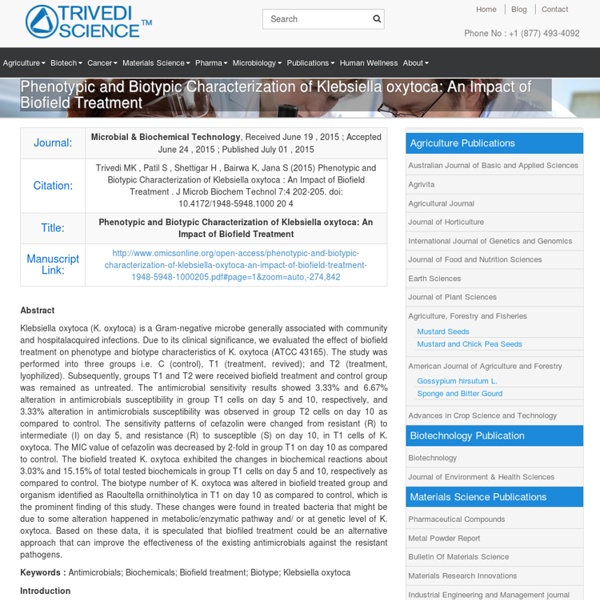



Biofield Treatment on Quality of Beef Extract and Meat Infusion Powder The present research work investigated the influence of bio-field treatment on two common flavoring agents used in food industries namely beef extract powder (BEP) and meat infusion powder (MIP). The treated powders were characterized by Fourier transform infrared spectroscopy (FT-IR), X-ray diffraction (XRD), particle size analysis, surface area analysis, differential scanning calorimetry (DSC), and thermogravimetric analysis (TGA). The FT-IR results showed disappearance of triglycerides peaks in both the treated powders as compared to control. XRD results corroborated the amorphous nature of both control and treated samples. The BEP showed enhanced average particle size (d50) and d99 (size exhibited by 99% of powder particles) by 5.7% and 16.1%, respectively as compared to control. Beef is known to have excellent nutritional value and it has been widely consumed in many countries.
Effect of Biofield Energy Treatment on Streptococcus group B: A Postpartum Pathogen - Trivedi Science Abstract: Streptococcus agalactiae group B (S. agalactiae gr. B) is widespread in nature mainly causes bacterial septicemia and neonatal meningitis. Impact Of Biofield Treatment On Salmonella Paratyphi A Abstract Enteric fever is a major global problem. Emergence of antimicrobial resistance threatens to render current treatments ineffective. The current study was attempted to investigate the effect of biofield treatment on Salmonella paratyphi A (S. paratyphi A) in terms of antimicrobial susceptibility assay, biochemical characteristics and biotyping.
Evaluation Of Biofield Treatment On Cancer Biomarkers Abstract Increasing cancer rates particularly in the developed world are associated with related lifestyle and environmental exposures. Combined immunotherapy and targeted therapies are the main treatment approaches in advanced and recurrent cancer. An alternate approach, energy medicine is increasingly used in life threatening problems to promote human wellness.
Biofield Treatment: An Alternative Approach to Combat Multidrug-Resistant Susceptibility Pattern of Raoultella ornithinolytica - Trivedi Science Abstract Raoultella ornithinolytica is belongs to the family of Enterobacteriaceae, a Gram-negative encapsulated aerobic bacillus associated with bacteremia and urinary tract infections. As biofield therapy is increasingly popular in biomedical heath care, so present study aimed to evaluate the impact of Mr. Trivedi’s biofield treatment on antimicrobial sensitivity, minimum inhibitory concentration (MIC), biochemical study, and biotype number of multidrug resistant strain of R. ornithinolytica. Clinical sample of R. ornithinolytica was divided into two groups i.e. control and biofield treated which were analyzed for the above parameters using MicroScan Walk-Away ® system on day 10 after treatment.
Effect of Biofield Treatment on Staphylococcus Species Abstract: Antimicrobial resistance is a global health issue in the developing countries. This study was carried out to evaluate the impact of Mr. Trivedi’s biofield energy treatment on multidrug resistant (MDR) clinical lab isolates (LSs) of Staphylococcus species viz. Staphylococcus haemolyticus (LS 18), Staphylococcus epidermidis (LS 21), and Staphylococcus aureus (LS 30).
"Improved Susceptibility Pattern of Antimicrobials Using Vital Energy T" by Mahendra Kumar Trivedi Description Complementary and alternative medicine (CAM) has become increasingly popular and reported for countless benefits in biomedical health care systems. The study assessed the potential impact of The Trivedi Effect® (biofield energy) on Shigella sonnei for changes in antimicrobial sensitivity, biochemical study, and biotype number using MicroScan Walk-Away® system. The cells were obtained from MicroBioLogics Inc., USA bearing the American Type Culture Collection (ATCC 9290) number, and divided into two groups, Group (Gr.) An Emerging Global Opportunistic Pathogen Abstract Stenotrophomonas maltophilia ( S. maltophilia ) is a Gram-negative bacillus, an opportunistic pathogen, particularly among nosocomial infections. Multi-drug resistant strains are associated with very high rate of morbidity and mortality in severely immunocompromised patients.
Impact of Biofield Treatment on Enterobacter Aerogenes Abstract: Enterobacter aerogenes (E. aerogenes) has been reported as the versatile opportunistic pathogen associated with the hospital infections worldwide. The aim of the study was to determine the impact of Mr. Physical, Thermal and Spectroscopic Studies of Biofield Treated <i>p</i>-Chlorobenzonitrile Physical, Thermal and Spectroscopic Studies of Biofield Treated p-Chlorobenzonitrile Science Journal of Chemistry Volume 3, Issue 6, December 2015, Pages: 84-90 Received: Sep. 19, 2015; Accepted: Sep. 30, 2015; Published: Oct. 16, 2015 DOI: 10.11648/j.sjc.20150306.11 Views 557 Downloads 25
Publication meta - Improved Susceptibility Pattern of Antimicrobials Using Vital Energy Treatment on Shigella sonnei Complementary and alternative medicine (CAM) has become increasingly popular and reported for countless benefits in biomedical health care systems. The study assessed the potential impact of The Trivedi Effect ® (biofield energy) on Shigella sonnei for changes in antimicrobial sensitivity, biochemical study, and biotype number using MicroScan Walk-Away ® system. The cells were obtained from MicroBioLogics Inc., USA bearing the American Type Culture Collection (ATCC 9290) number, and divided into two groups, Group (Gr.) I: control and Gr.
Spectroscopic Characterization of Chloramphenicol and Tetracycline: An Impact of Biofield Treatment - Trivedi Science Abstract Objective: Chloramphenicol and tetracycline are broad-spectrum antibiotics and widely used against variety of microbial infections. Nowadays, several microbes have acquired resistance to chloramphenicol and tetracycline. The present study was aimed to evaluate the impact of biofield treatment for spectroscopic characterization of chloramphenicol and tetracycline using FT-IR and UV-Vis spectroscopy. Physicochemical and Spectroscopic Characterization of Biofield Treated Triphenyl Phosphate Physicochemical and Spectroscopic Characterization of Biofield Treated Triphenyl Phosphate American Journal of Applied Chemistry Volume 3, Issue 5, October 2015, Pages: 168-173 Received: Sep. 15, 2015; Accepted: Sep. 26, 2015; Published: Oct. 15, 2015 Views 1163 Downloads 26 Authors